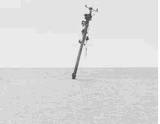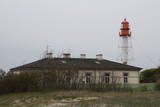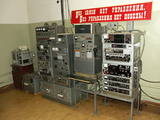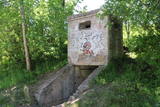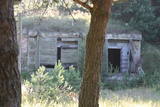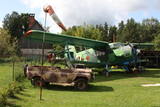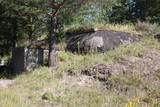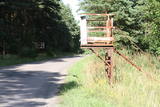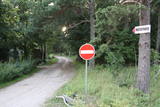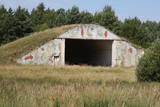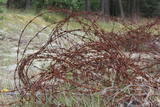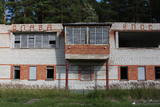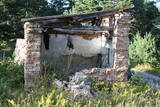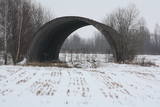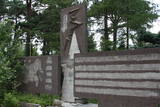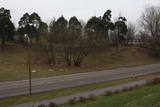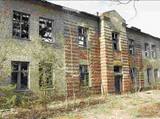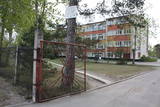| Nr | Nosaukums | Apraksts |
|---|---|---|
|
Papes aviācijas poligonā, kas atradās jūrā, netālu no krasta - notikusi šaušanas apmācība un aviācijas bumbu mešana uz mērķiem. Jūrā saglabājušies bijušie nogremdētie kuģu vraki un mērķi. Virs ūdens saglabājies vien kuģa masts. Pēc Andra Maisiņa sniegtās informācijas, arī Papes ezera ziemeļdaļā ir bijis aviācijas mērķis - no riiepām veidots lidmašīnas siluets.
|
||
|
Padomju laikā visas bākas bija militāra statusa objekti, arī Papes bāka. Šobrīd bāku apsaimnieko Latvijas Jūras administrācija un tā ir apskatāma tikai no ārpuses.
|
||
|
Šis īpaši slepenais bunkurs ar segvārdu "Pansionāts" bija viena no stratēģiski svarīgākajām vietām Padomju Latvijā kodolkara situācijas gadījumā. Rehabilitācijas centra "Līgatne" teritorijā 9m dziļumā zem zemes atrodas labiekārtots bunkurs, no kura kara gadījumā tiktu vadīta valsts, kur uzturētos tās galvenās civilās un militārās personas, kas palīdzētu izdzīvot republikai kodolkara apstākļos. Bunkuram slepenības zīmogu noņēma tikai 2003. gadā, kamdēļ līdz mūsdienām ir saglabājies viss autentiskais pazemes aprīkojums. Bunkuru var apskatīt zinoša gida pavadībā, kā arī paēst tipiskas padomju laika pusdienas. Šāda tipa objekts tik labā stāvoklī ir vienīgais Baltijas valstīs, iespējams - arī vienīgais visā padomju bloka valstīs.
|
||
|
Viena no slepenākajām vietām kādreizējā Padomju Latvijā - bunkuri ir bijušais raķešu vadības punkts un patvertne. Bunkurus izveidoja 1950. un 1960. gadu mijā Padomju armijas vajadzībām. Par atrašanos šajā teritorijā draudēja bargs sods. Celtnes izveidošanai ar milzīgām 16- riteņu kravas automašīnām tika atvesti lieli dzelzbetona bloki. Pēc trīs bunkuru izveidošanas, papildus nostiprināšanai un nosiltināšanai tos apbēra ar granti. Celtne sastāv no 2 x 3 sekcijām, kas pievienotas vidējam gaitenim. Blakus ēkā atradās skola, kad 1946. gadā tā daļēji bija izdegusi, tika noslēgts līgums ar Padomju armijas garnizonu par telpu īri. Tā Valkas pilsētas centrā radās militārais centrs un Valka kļuva par Padomju Savienībai svarīgu kodolbruņojuma objektu. Objekts pieejams tikai no ārpuses! |
||
|
Armijas 77.Zenītraķešu brigādes uzdevums Padomju savienības laikā - savienības ārējās robežas pretgaisa aizsardzība. Šobrīd objekts pieder novada pašvaldībai, ir pamests, neapsargāts un netiek izmantots. Pie raķešu bāzes galvenās ieejas saglabājušies interesanti vārti.
|
||
|
Vienīgā Latvijas kafejnīca, kurai ir ļoti neparasts - militārās tehnikas un citu atribūtu, t.sk. - Padomju armijas interjers. Arī tās dārzā ir apskatāmi interesanti eksponāti - artilērijas šāviņi, lidmašīna, kara automašīnas u.c. Tiešām vērts ieiet un izdzert kafiju.
|
||
|
Apmēram pusotru kilometru austrumos no Lūžņas pie Lūžas ietekas Baltijas jūrā atrodas vēl viena krasta batereja. Turpat arī padomju armijas militāro būvju paliekas.
|
||
|
Ozoliņu robežapsardzības daļā kādreiz atradās sakarnieki un mācību centrs. Šobrīd objektā pēc pieeiamām ziņām izvietots Ventspils zemessardzes bataljona štābs un kazarmas. Civilpersonām nepieejama teritorija. Pie ceļa, kas ved Liepājas virzienā saglabājušās metāla konstrukcijas - bijusī caurlaides un dokumentu pārbaudes vieta. Šādi kontrolpunkti bija izvietoti tur, kur sākās pierobežas režīms - civilām personām un tiem, kas nebija vietējie iedzīvotāji - nepieejama teritorija. Vai tiešām neviens neparūpēsies, lai šis, šķiet, vienīgais šāda veida Latvijā saglabājies objekts tiktu saglabāts nākamībai?
|
||
|
Bijušā Jūrkalnes Padomju pretgaisa aizsardzības diviziona daļa šobrīd atrodas privātīpašumā un tur izveidota mototrase.
|
||
|
Ziemupes 158.zenītraķešu bāzes vietā saglabājušās dažas ēkas, raķešu novietnes un dzīvojamā ēka. Objekts netiek izmantots, teritorija pamesta un degradēta. To var lieliski pārskatīt no blakus esošā zemes ceļa.
|
||
|
Raķešu bāze pretgaisa aizsardzībai izvietota plašā teritorijā dienvidos no Pāvilostas. Pamesta un degradēta dabas teritorija, kur izvietotas brīdinājuma zīmes "Bīstami, apdraud dzīvību".
|
||
|
Skujnieku šautuve tikusi izmantota vasaras sporta nodarbību vajadzībām, šaušanas apmācībām un treniņiem. Ir atrodama informācija, ka arī mūsdienās šautuve brīžiem tiek izmantota militārām vajadzībām. Teritorijā saglabājusies 1982.gadā celtā vadības ēka ar uzrakstiem krievu valodā "Слава КПСС" (Slava Padomju Savienības Komunistiskajai partijai). Kur vēl šādus uzrakstus "brīvā dabā" ir iespējams redzēt?
|
||
|
Arī pie Užavas ciema Padomju laikā atradies krasta robežapsardzības postenis. Par tā pašreizējo izmantojumu vēl trūkst informācijas, bet kopumā teritorija izskatās pamesta un neapsaimniekota. Ēku stāvoklis ir nožēlojams. Saglabājušies zemes vaļņi, bijušās noliktavas (?), asfaltēti laukumi un sarkani ieejas vārti.
|
||
|
Šķiet, ka viena no mūsdienās „teiksmām” visapvītākā Padomju armijas teritorija. Padomju laikā šeit atradās rezerves aviācijas lidlauks, kodolieroču noliktavas (... 50 km attālumā no valsts galvaspilsētas), kas bija nomaskētas zem diviem ar zemi apbērtiem un veģetāciju apaudzētiem betona angāriem. Publiskajā vidē ir atrodamas ziņas, ka noliktavās ir glabājusies 430 km smaga termiskā kodolbumba RX – 24 un 1030 kg smagā RX – 26 koldolbumba ar dažāda tipa kodollādiņiem, kā arī ar kodollādiņiem aprīkotās gaiss – zeme tipa raķetes. Kas gan būtu palicis pāri no Rīgas un valsts (Baltijas valstīm? Ziemeļeiropas?), ja šeit būtu noticis kāds negadījums? Šobrīd lidlauks ir slēgta teritorija.
|
||
|
Ventspils Padomju laika robežapsardzības daļu veido fundamentāls ēku, laukumu un dažādu objektu komplekss, kas šobrīd ir pamests un neapsargāts, izņemot atsevišķas tā ēkas. Saglabājušies arī attiecīgā laika pieminekļi un padomju laika simbolika uz ēku sienām, kas patiesībā jau šobrīd ir unikāla, bet nenovērtēta vēstures liecība.
|
||
|
Vieta, kur pēc pieejamās informācijas atradās militāriem mērķiem domātu aviācijas motoru izmēģinājumu laboratorija. Mūsdienās par to nekas vairs neliecina, jo tā ir industriāla un nepieejama teritorija.
|
||
|
Eiropā un, domājams, pasaulē unikāls militāro būvju komplekss, kas izvietots starp Baltijas jūru un Liepājas un Tosmares ezeriem. Cietoksnis izmaksāja 45 miljonus zelta rubļus, un to sāka būvēt 19. gs. beigās pēc Krievijas cara Aleksandra III pavēles. Tas sastāvēja no kara pilsētiņas un fortifikācijas būvēm - lielgabalu pozīcijām, bunkuriem, pulvera pagrabiem, kanālu sistēmas, šaursliežu dzelzceļa u.c. 1908. g. saskaņā ar jauno Krievijas aizsardzības koncepciju cietoksnis beidza funkcionēt, jo tā celtniecību atzina par stratēģisku kļūdu. Pazemes būves un pagrabus 1. pasaules kara laikā mēģināja uzspridzināt, taču tas īsti neizdevās. Tā atsevišķiem elementiem bija liela nozīme Latvijas atbrīvošanas cīņās. Līdz mūsdienām saglabājušās atsevišķas cietokšņa daļas - Ziemeļu forti, Vidusforts, Austrumu forts, Dienvidu forts, krasta aizsardzības baterijas (Nr. 23., 3.), Redāns, Lunete u.c. Lielākā daļa no tiem nav labiekārtoti, tādēļ to atsevišķu daļu apskate var būt bīstama. Bijušā cietokšņa ziemeļdaļa ietver Karostu, kas piedzīvojusi septiņas dažādas armijas un varas. Padomju laikos Karosta bija slēgtā zona un civilpersonām nepieejama. Te atrodas daudzi izcili militārās vēstures pieminekļi un tūristu iecienītais Karostas cietums. |
||
|
Jūras apsardzes rajons ar zenītraķešu divizionu Miķeļtornī tikusi īpaši veidota Padomju savienības ārējās robežas aizsardzībai. Pašlaik teritorijā tiek izmantota tikai robežsargu bijušā teritorija, kur izvietots Ventspils krasta apsardzes bataljona novērošanas punkts.
|
||
|
Ventspils rajona Liepene atrodas bijušās jūras robežapsardzes daļa, kas šobrīd ir privātīpašums un tiek izmantota kā tūrisma mītne.
|
||
|
Bijušā Liepājas Karostas Jūras karaflotes 94. autoskolas vietā šobrīd atrodas Liepājas pilsētas 3.pamatskola. Ēka labi redzama no blakus esošās ielas. Šķiet, ka pie iebrauktuves saglabājušies vecie armijas vārti ar attiecīgo simboliku.
|
||
